August 30, 2007
By Al Dean
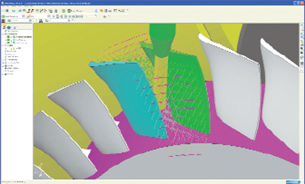 PowerMill now has specialized tools to assist with quickly creating reliable toolpaths for both blisk (as shown) and impeller machining. Both sides of a blade are being machined in a single operation. |
A major concentration for the last PowerMill release was support for engine port machining. These tools provided existing machining strategies grouped to task-specific operation — that of machining the seemingly unreachable internal cavities found in cylinder blocks. PowerMill 8 offers the same concept of taking existing technology and creating task-specific functionality applied to the machining of blisks (turbine blades) and impellers.
There are three major components or factors to consider when looking at blisks or impellers — the blades themselves, the hub, and the shroud. The new tools take machining strategies that can handle these types of geometry and repurpose them by using turbo machinery terminology and processes. The core operations provided in PowerMill are Area clearance (Roughing), Blade Finishing, and Hub finishing; use of these differs between blisks and impellers — so let’s take a look.
The blisk machining tools let you work in one of two ways, either on a single pair of blades (the front of one, rear of another), which are then axially patterned. Alternatively, if the spacing is symmetrical, you can define the operations to handle the part in a single operation set. The wizard-driven process asks you to define the various geometry that makes up the three key areas (blade, hub, and outer shroud), the roughing operation between blades, how blades are finished, and then the central hub finishing. You have full control over the process including how the cutter is aligned in the toolpaths. It’s worth noting that cutter axis control has also been improved in this release to make it more editable and controllable. The same dialog is used for impellers, but as these are typically more complex (in terms of the inclusion of splitters and more complex hub forms), you have more options and variables to define. The integration of splitters is interesting — as simply defining the geometry means that those smaller blade forms are accommodated in many operations.
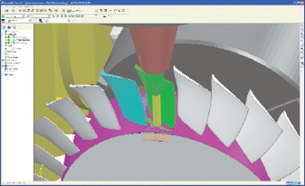 Improvements have been made across all of PowerMill’s operations in the area of cutter axis control. Here the program assists with hub machining, to ensure that the cutter is aligned to the hub (the central cylindrical form) in the manner the user requires. |
Of course, if you look at any blisk or impeller machining process, it’s pretty clear that the only way you’re going to machine it effectively is using full 5-axis movement in the cutter — and when you’re machining these types of shapes, you need to ensure that the cutter and tool holder can reach all areas, that the machine can move in the desired way, and that there’s no collision or gouging. As a result, collision and gouge detection is built directly into all of these operations — which leads me nicely onto another key area for PowerMill 8.0 — simulation and verification.
Machining simulation & verification
In previous releases, PowerMill separated the ViewMill tool for simulating material removal and surface finish from full machine simulation. This release consolidates these tools so both can run concurrently and more dynamically, allowing you to interact with the view in a single window. This is particularly critical for complex 5-axis machining operations where the movement of the machine and the parts means that you need to be able to change the view as the machine moves.
Resolution of the ViewMill portion isn’t the highest quality during the simulation but you can halt the simulation at any time and see a much higher quality representation of the surface finish you’re going to get.
Also on the subject of verification, for those that use or are required to use Vericut to verify their machining operations (as is common in the aerospace industry when handling particularly high-value material), the transfer of data between PowerMill and Vericut has been optimized. The Vericut interface application will take the PowerMill project information and transfer it directly to the application, saving a great deal of rework.
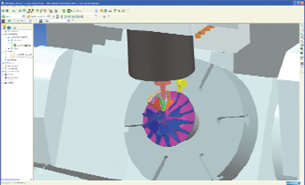 Here an impeller-based toolpath is being simulated alongside full machine simulation, allowing you a complete visualization of your operation and the movement of all the critical components. | 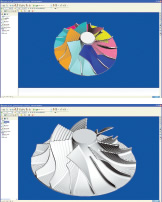 While it’s possible to view both cutter movement and machine simulation in a single window, ViewMill — for more accurate material removal simulation — is still available for those seeking to inspect surface finish. |
Another area in PowerMill that’s been consolidated is the Tool Database. Previous releases required that the user maintain separate tool databases for different materials/machines. This changes with PowerMill 8.0 and all of these disparate sources of information are now consolidated into a single database. This allows you to standardize your information and helps find the information you want much more quickly using filters. For example, you can filter cutters by type (end mill, ball nose), diameter, flute length (and no. of flutes), tip radius, etc. You can either enter data from cutting tool catalogues, add the data manually or, as you use cutters from existing operations, you can right click them and add them to the database.
High-End Machining At its Best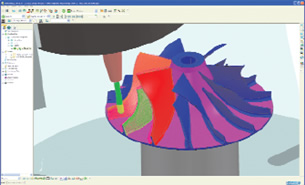
The impeller-focused tools automatically handle splitter blade forms and incorporate their machining in the main blade operations.
With PowerMill 8.0, Delcam has provided a tool that is well established in both high-speed and complex multi-axis machining of complex forms. This mastery of complex machining tasks is evident in PowerMill’s development over these past few years.
The general-purpose operations have been consolidated into a growing number of product-specific operations that remove the pain from performing complex machining tasks. In addition, the work done to the user interface means that you have an environment in which you can bring in complex geometry and get that part machined in an intelligent manner, taking advantage of the benefits of collision detection and machine simulation and the complexities of high-speed and 5-axis machining methods and — most importantly — out the door again in a much shorter timeframe, which is what most machine shops are all about.
The release of PowerMill 8 brings such efficiency closer to reality and, while PowerMill is one of the most powerful CAM environments currently available, that power is supported by a smart interface that helps — rather than hinders — the generation of optimized toolpaths.
For More Information:
PowerMill 8.0
Delcam
Salt Lake City, UT
delcam.com
Al Dean is technology editor at MCAD Magazine, a UK product development and manufacturing technology journal (mcadonline.com) and is editor of Prototype magazine (prototypemagazine.com). He’s still baffled as to why he ended up writing about technology instead of drawing stuff for a living. Please feel free to send comments about this article to DE-Editorsmailto:[email protected].
Subscribe to our FREE magazine, FREE email newsletters or both!
About the Author
DE’s editors contribute news and new product announcements to Digital Engineering.
Press releases may be sent to them via [email protected].






